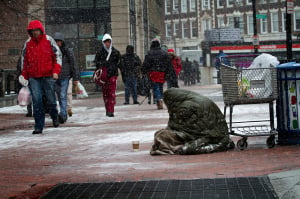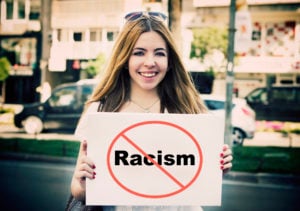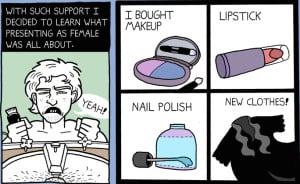
A group of people meditating.
This article was originally published on Threads of Solidarity and republished here with the author’s permission.
The strong, Black woman. The Asian “model minority.” “¡No soy loco!”
These tropes, expressions, and labels are often used to demonstrate (and even celebrate) the “resiliency” of people of color. But it’s a trap. These stereotypes may seem empowering, but beneath the surface, they are damaging.
By denying our humanity, we downplay the mental-health effects of racial trauma. We perpetuate the stigma of mental illness in our communities. And we ignore our own pain and suffering.
Mental illness does not discriminate on the basis of identity or background. Why, then, are people of color often silenced, ignored, and excluded from the discussion?
White-centricism not only takes over the narrative of mental health, it consumes media representation, access to services/resources, and even community support. People of color aren’t visible in this conversation, and that alone impacts our mental health by making it harder for us to believe and identify our struggles.
And people of color not only feel left out, we get left out. Racial minorities in the U.S. are less likely overall to access mental health services for reasons including cultural and socioeconomic barriers.
When we DO receive care, it is often poorer quality. Access to culturally competent care is also an obstacle for communities of color. For example, only 5% of psychologists are African Americans.
The history of racism in mental health care is well-documented, and even today, there is still a clear bias against people of color.
From diagnostic disparities to pathologizing and gaslighting those suffering from racial trauma, white mental health practitioners have little sense of cultural competency in serving people of color and can reinforce stigma and induce more harm.
When confronted by their lack of knowledge, white therapists often retraumatize us with their own white fragility and rage.
Meanwhile, the social impact is devastating. Our communities are in crisis.
People of color are disproportionately more likely to experience race-based trauma and PTSD, with Native Americans experiencing significantly higher rates. Asian-American women have the second highest suicide rate in the country. Islamophobia has taken a mental and physical toll on Muslim Americans with nearly one-fourth suffering from depression. Both Black and Latinx people face higher rates of depression than white people.
Is it any wonder that suicide rates in communities of color are on the rise?
But despite the obstacles we face, our people can heal and our communities can thrive. Our survival and continued existence is a tribute to our strength and resilience. Loving ourselves in the process is radical resistance. But we do not have to give from an empty cup or suffer in silence.
Read the following five tips to find out how people of color can foster mental health and practice restorative healing.
1. De-stigmatize mental health
Normalize mental health as a social justice issue by breaking down barriers to seeking help. Share your narrative as an act of “self-love, liberation and reclamation,” an inspiration to others that can potentially save lives. Use the following resources to open awareness and dialogue:
- Take the Stigma Free Pledge and be conscious of words and language that stigmatize mental illness.
- Watch this 3-minute video by writer and activist Imade Nibokun, about depression, the intersection of mental health and social justice, and how the suicide of MarShawn McCarrel was a catalyst for addressing activist self-care.
- Visit the People of Color & Mental Illness Photo Project created by Dior Vargas, a Latina feminist mental health care activist, and follow on Facebook and Twitter. Consider submitting your photo to be included in the project.
- Read this series that addresses the stigma of mental health in young Asian Americans, “model minority” expectations, and how practitioners, parents, peers, and schools can help break down barriers.
- Read the educational fact sheets from Brother, You’re on My Mind Toolkit and use their tips and resources for advocacy, community outreach, events, and partnerships for African-American communities.
- Keep in mind that the seemingly strongest among us are sometimes the most at risk. Especially those in activist spaces can use uplifting and room for just being and being vulnerable. Reach out, check in, share the load.
2. Seek culturally competent mental health services
Follow these 3 tips to finding mental health care from My Brown Box.
Look at recommendations from the National Alliance on Mental Illness on how to find a culturally competent therapist for the specific needs of African American and Latinx people. Check out these resources and directories of practitioners of color:
- Click on your state in the Therapy for Black Girls directory, which lists therapists who have been identified as doing great work with Black women.
- Find Black therapists at AfricanAmericanTherapists.com and The Association of Black Psychologists.
- Read this guide, Going To Therapy As A QTPOC, Without Being Harmed, Erased Or Baffled, and find queer and trans therapists of color through the National Queer & Trans Therapists of Color Network.
- Find outpatient services tailored for Asian Americans using Hyphen Magazine’s resource guide.
- Find a therapist or psychiatrist of color near you through the Tessera Collective or choose the specific race/ethnic parameters you’re looking for using Psychology Today’s clinician directory.
- Islamic Counseling is based in the UK, but their helpful links page has some counselors available for Skype sessions. Watch their 4-minute video about Islamic Counseling.
- Try out one of these 12 mental health apps, each designed for a specific purpose (to ease insomnia; improve mood; stop self-harm; etc.).
- Text 741741 from anywhere in the U.S. to chat with a trained crisis counselor through Crisis Text Online.
3. Practice self-care
Rejuvenate using these resources specifically tailored for people of color. Self-care and self-love are crucial and radical acts of resistance.
- Listen to these 5 mental health podcasts by therapists of color.
- Read these 5 mental health blogs created for people of color.
- Bookmark this Black Lives Matter Meditation for healing racial trauma.
- Visit Activist Trauma Support to get tips on handling panic attacks, PTSD, and burnout.
- Find resources and tips specifically for Black girls and women at the Black Girl + Mental Health blog.
- Learn how 11 Black Queer and Trans Women practice self-care.
- Follow daily coping tips throughout the month of July from The Steve Fund, which promotes the mental health and emotional well-being of young people of color.
- Just say “No” — use these survival tips for strong Black womens’ depletion prevention.
- Read the Young People of Color Self Help Guide, which provides insight on the specific mental health issues affecting young people of color.
4. Endorse multicultural and social justice counseling competencies
De-center and decolonize white supremacy models of mental health and treatment. Seek out, research, and listen to sources of knowledge from marginalized, underserved, and neglected communities about mental health beliefs, healing, and community needs.
- Read this document from the presentation Culturally-Responsive Counseling in the Era of Community-Wide Racial Stress, review and select racially based stress assessment tools found on page 20, and read additional resources for interventions on page 25.
- If you are a white mental health professional, work to make your practice anti-racist. This issue from Mental Health News on “The Impact of Race and Racism on Mental Health Clients, Practitioners, Organizations, and Delivery Systems” offers insights and tips. Take this Cultural Competence Self-Assessment Questionnaire found in Appendix A and evaluate what areas in your practice can use some remediation. Explore the abundance of resources from the National Center for Cultural Competence for mental health care providers and programs to deliver culturally and linguistically competent services. Get familiar with these endorsed competencies.
5. Support mental health organizations for and by people of color
Those who are able must prioritize financially supporting mental health services that are accessible to people of color. This is a call to action: amazing mental health organizations and services centering people of color can’t always sustain themselves without our help.
- Black Emotional And Mental Health Collective (BEAM) is a multidisciplinary collective of mental health healers and activists. They develop trainings, technical assistance, and educational offerings that are based on “social justice informed informed mental health literacy” designed by and for Black communities.” #BlackLight is their social media campaign for highlighting mental health and healing in Black communities. Follow them on Facebook and Twitter and join their mailing list to stay up to date. Donate here with a one-time contribution or with monthly support.
- Rest for Resistance has a repository of resources about mental health for queer and trans people of color. They offer online peer support, community (Brooklyn) monthly meditations, a weekly online zine that publishes works by QTPoC related to “healing, self-care, emotional wellness, survival, and navigating all that along with oppression.” They have a social media presence on Facebook and Twitter that is both uplifting and educational. Donate here (various options).
- National Queer & Trans Therapists of Color Network is an all-volunteer endeavor, founded by queer, gender non-conforming, and trans therapists of color who are committed to healing and interrupting the consequences of oppression. Their work is about building capacity for being transformative mental health healers while supporting each other through the racism and barriers faced on their journey as students and professionals. Their Facebook page and Google site are dedicated spaces only for queer and trans people of color with weekly content, resources, and information related to healing and mental health providers. A monthly newsletter is offered for all to stay informed and connected. Donate through the PayPal link found at the bottom of the NQTTCN home page.
[do_widget id=’text-101′]
Threads of Solidarity is a collective voice for women of color solidarity and liberation. Our goal is to strengthen the voices of women of color in the anti-oppression fight and provide resources as well as action items to continue working towards racial justice.
Search our 3000+ articles!
Read our articles about:
Our online racial justice training
Used by hundreds of universities, non-profits, and businesses.
Click to learn more




















